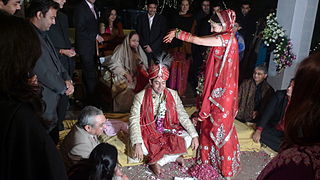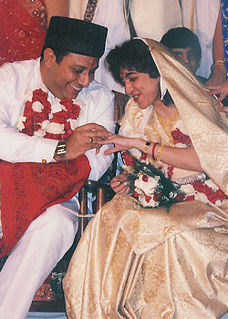See also
| This disambiguation page lists articles associated with the title Bridegroom. If an internal link led you here, you may wish to change the link to point directly to the intended article. |
A bridegroom (or groom) is a male wedding partner.
It may also refer to:
| This disambiguation page lists articles associated with the title Bridegroom. If an internal link led you here, you may wish to change the link to point directly to the intended article. |

A wedding is a ceremony where two people are united in marriage. Wedding traditions and customs vary greatly between cultures, ethnic groups, religions, countries, and social classes. Most wedding ceremonies involve an exchange of marriage vows by a couple, presentation of a gift, and a public proclamation of marriage by an authority figure or celebrant. Special wedding garments are often worn, and the ceremony is sometimes followed by a wedding reception. Music, poetry, prayers, or readings from religious texts or literature are also commonly incorporated into the ceremony, as well as superstitious customs originating in Ancient Rome.
A groom is a male participant in a wedding ceremony.

The Cirebonese or Cirebonese people are an Austronesian ethnic group and nation native on the city of Cirebon and its immediate surrounding area, located in the northern part of the island of Java in Indonesia. Numbering approximately 1.9 million, the Cirebonese are mostly Muslim. Their language, Cirebonese, is a mixture of Javanese and Sundanese, with a heavier influence from Javanese, and as such is variably classified as either a dialect of both of those languages or as an independent language.
Sakharpuda is the Maharashtrian Engagement ceremony. The correct name of the ceremony "Rupaya Naral - Sakharpuda". It is also known as "Waangnischay" which literally means verbal agreement.

Vivāha (Sanskrit) or Vivaah is marriage as it is practiced by Hindus in the Indian subcontinent. The word vivāha originated as a sacred union of people as per Vedic traditions, i.e. what many call marriage, but based on cosmic laws and advanced ancient practices. Under Vedic Hindu traditions, marriage is viewed as one of the saṁskāras, which are lifelong commitments of one wife and one husband. In India, marriage has been looked upon as having been designed by the cosmos and considered as a "sacred oneness witnessed by fire itself." Hindu families are patrilocal.
Rajputs traditionally have their own distinct individual rituals of marriage. Marriage is considered one of the most important events in a couple's lives and it's created as a bond for seven lives. These wedding rituals and traditions date back to a long time ago, and has been very greatly preserved by Rajput communities, all over the Indian subcontinent.

An Ayyavazhi wedding is the wedding custom within the Ayyavazhi belief system of South India. Usually Dharmagharttas, Panividaiyalars from Thangals or an older person experienced in Ayyavazhi assumes a role as a Guru and is seated in the Manvarai for leading the wedding ceremony.
Iranian wedding, also known as Persian wedding, traditions go back to the Zoroastrianism, which was the religion of pre-Islamic Iran despite their local and regional variations. Though the concepts and theory of the marriage have been changed by Islamic traditions, the actual ceremonies have remained more or less the same as they were originally in the ancient Iranian culture. Although modern-day Iran is a multi-ethnic country, Iranian wedding traditions are observed by the majority of ethnic groups in Iran.
Punjabi wedding traditions are a strong reflection of Punjabi culture with ritual, song, dance, food, and dress that have evolved over centuries.

Zoroastrian weddings, similar to Parsi weddings, are a religious ceremony in Zoroastrianism in which two individuals, a man and a woman are united. In Zoroastrianism, marriage within the community is encouraged, and is greatly favored in religious texts. The following information will detail ceremony procedures and traditional processes for a Zoroastrian wedding.
A bridesman is a close male relative and/or friend of the bride, one who walks down the aisle in the bridal ceremony in the traditional place of a bridesmaid.
Ukrainian wedding is the traditional marriage ceremony in Ukrainian culture, both in Ukraine and in the Ukrainian diaspora. The traditional Ukrainian wedding featured a rich assortment of folk music and singing, dancing, and visual art, with rituals dating back to the pre-Christian era. Over time, the ancient pagan traditions and symbols were integrated into Christian ones.

Indian wedding clothes are elaborate set of clothes worn by the bride, bridegroom and other relatives attending the wedding.
Groom kidnapping, colloquially known as Pakaruah shaadi or Jabaria shaadi, is a phenomenon in the western parts of Bihar, and eastern Uttar Pradesh states in India, wherein eligible bachelors are abducted by the bride's family and later forcefully married, to avoid heavy dowry costs. Considering the traditional regard for the marriage sacrament, most such marriages are not annulled. Additionally, the groom may suffer criminal charges under Indian dowry law, and end up fighting lengthy legal battles.

A bridegroom is a man who will soon be or has recently been married. A bridegroom is typically attended by a best man and groomsmen.
An Odia Hindu wedding, or bahaghara, is a wedding ceremony performed by Odia Hindu people in the Indian state of Odisha. There are subtle differences in the rites observed by different castes. In Odia marriage rituals the mother of the bridegroom does not take part in the ceremony. The Utkala Brahmins have their weddings only in the daytime, preferably at midday or in the morning, while the other caste weddings are done during the evening or night. There is the custom of sending betel nuts to family friends for inviting them to the marriage. The first invitation is sent to the family deity as a respect to the lord. Marriages in Odisha are mostly fixed and arranged by the parents. Marriages for serving or capturing is not common. In the Odia community widow remarriage is allowed in some lower caste, in this case the younger brother is allowed to marry the deceased brother's wife. The marriage happens in three major rituals, Nirbandha, Bahaghara (wedding) and Chauthi/Chaturthi (consummation). A marriage is not considered complete or valid until consummation. These rituals are performed either at the Duara or Tola kanias house.
Aval Sumangalithan is a 1985 Tamil-language drama film directed by Visu. The film features Karthik and Ilavarasi in lead roles. The film, produced by Rajam Balachander and Pushpa Kandaswamy, had musical score by M. S. Viswanathan and was released on 19 July 1985. The film was remade in Telugu as Punyasthree.

Eddie Sturgis, also known as Edwin Sturgis, Ed Sturgis, or Edward Sturgis, was an American character actor of the silent and sound film eras. His career began in the 1916 film, The Lost Bridegroom, which starred John Barrymore. In his twenty-three year career, he appeared in over fifty films, mostly in supporting or smaller roles. His final performance would be in the 1939 Joe E. Brown vehicle, Beware, Spooks!, in a minor role. Sturgis died on December 13, 1947 in Los Angeles, California.

Traditional Hajong marriage is a ceremonial ritual that involves a marriage established by pre-arrangement between families. Within Hajong culture, romantic love and widow re-marriage was allowed, and monogamy was the norm for the Hajong people.
The Bridegroom's Dilemma was an 1899 French short silent comedy film by Georges Méliès. It was sold by Méliès's Star Film Company and is numbered 177–178 in its catalogues, where it is advertised as a scène comique.